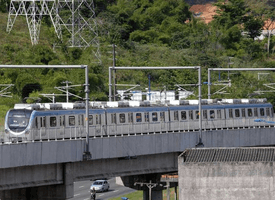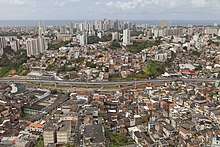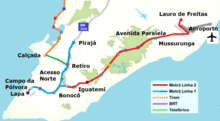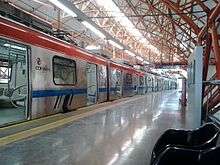Salvador Metro
The Salvador Metro (Brazilian Portuguese: Metrô de Salvador, commonly called Metrô or Sistema Metropolitano Salvador-Lauro de Freitas) is a rapid transit system serving Salvador city, the state capital of Bahia and the fourth largest city in Brazil. The current system includes a fully open 33 KM and twenty, which began partial public service on June 11, 2014.[2] The system arrives until the center of the city of Lauro de Freitas also. It is operated by CCR METRÔ BAHIA Company.
 A train on the Salvador Metro. | |||||||||||||||||||||||||||||||||||||||||||||||||||||||||||||||||||||
| Overview | |||||||||||||||||||||||||||||||||||||||||||||||||||||||||||||||||||||
|---|---|---|---|---|---|---|---|---|---|---|---|---|---|---|---|---|---|---|---|---|---|---|---|---|---|---|---|---|---|---|---|---|---|---|---|---|---|---|---|---|---|---|---|---|---|---|---|---|---|---|---|---|---|---|---|---|---|---|---|---|---|---|---|---|---|---|---|---|---|
| Native name | Metrô de Salvador, Metrô Bahia | ||||||||||||||||||||||||||||||||||||||||||||||||||||||||||||||||||||
| Locale | Salvador, Bahia, Brazil | ||||||||||||||||||||||||||||||||||||||||||||||||||||||||||||||||||||
| Transit type | Rapid transit | ||||||||||||||||||||||||||||||||||||||||||||||||||||||||||||||||||||
| Number of lines | 2 [1] | ||||||||||||||||||||||||||||||||||||||||||||||||||||||||||||||||||||
| Line number | 2 | ||||||||||||||||||||||||||||||||||||||||||||||||||||||||||||||||||||
| Number of stations | 20 | ||||||||||||||||||||||||||||||||||||||||||||||||||||||||||||||||||||
| Website | CCR Metrô Bahia (in Portuguese) | ||||||||||||||||||||||||||||||||||||||||||||||||||||||||||||||||||||
| Operation | |||||||||||||||||||||||||||||||||||||||||||||||||||||||||||||||||||||
| Began operation | 2014 | ||||||||||||||||||||||||||||||||||||||||||||||||||||||||||||||||||||
| Number of vehicles | 45 | ||||||||||||||||||||||||||||||||||||||||||||||||||||||||||||||||||||
| Technical | |||||||||||||||||||||||||||||||||||||||||||||||||||||||||||||||||||||
| Track gauge | 1,435 mm (4 ft 8 1⁄2 in) standard gauge | ||||||||||||||||||||||||||||||||||||||||||||||||||||||||||||||||||||
| Electrification | 3,000 V overhead lines | ||||||||||||||||||||||||||||||||||||||||||||||||||||||||||||||||||||
| |||||||||||||||||||||||||||||||||||||||||||||||||||||||||||||||||||||

Additionally, Salvador is served by a 14-kilometre (8.7 mi) 1,000 mm (3 ft 3 3⁄8 in) metre gauge railway line known as the Suburban Line (Calçada-Paripe) that does not connect with the Metro in the year of 2018. This suburban line will soon become a VLT line integrated to the 43 KM of the subway of Salvador.
The construction of the SMSL is carried out in an expansion divided in six stages that will integrate the traditional center of the city until Pirajá (later, until the district of Águas Claras, near Cajazeiras), and until the neighboring municipality of Lauro de Freitas through Line 1 and Line 2 respectively, totaling 41.8 kilometers (17.6 of Line 1 and 24.2 of Line 2) and 22 stations.
As part of the efforts to implement integrated transportation in Greater Salvador, the subway assumes the role of structural trunk system, while the others must be complementary and feeder. Therefore, according to the requirement of integration put in the edict of the subway bidding of 2013, the subway is planned to coordinate with other related modalities: the Suburb Train, which currently operates with 13.5 kilometers of extension and 10 stations and must be replaced by the SkyRail Bahia monorail line, with the Blue Line and Red Line, which are transverse feeder roads in deployment to be covered by a Bus Rapid Transit System (BRT), with conventional Soteropolitan municipal bus lines, of Laurofreitenses municipal buses and with the metropolitan ones.
Background
The project is a Build, Operate, and Transfer (BOT) scheme for the operation of the urban rapid rail transportation system in the municipality of Salvador da Bahia, and includes the supply and installation of rolling stock and signaling equipment, and commercial operation of the system for the 25-year concession. Each train, consisting of four cars, has the capacity to carry 1,250 passengers.[3]
Currently, the urban transportation system in Salvador is underdeveloped and largely road-based, causing significant congestion and delays. This level of road-based transport has significant impacts on the local economy and environment. For this reason the municipality and the state, together with the World Bank, have been involved since 1992 in the design and implementation of a transportation strategy. The international standard gauge is 3 kV overhead power supply. And Built by a consortium of Siemens and Camargo Corrêa and Andrade Gutierrez of Brazil.[4]
_(23830098011).jpg)
This project is an integral part of the strategy. The project aims to improve the quality of public urban transportation in the area by connecting currently excluded low-income neighborhoods, and by furthering the development of a fully integrated urban transportation system.[5]
Salvador Metro system is one of the systems of urban mobility that were deployed for the 2014 FIFA World Cup. The connection of Line 2 with Line 1 of Salvador Metro contributes to connect the International Airport to Downtown Salvador and the Fonte Nova Stadium. The new Line 2 of Salvador Metro integrates the metro stations of the Rótula do Abacaxi and the beach city of Lauro de Freitas in the metropolitan area, passing through the Salvador International Airport, with the Airport metro station.[6]
Operations
Route

The current route of Line 1 begins at the underground Lapa station, and runs for 1.4 kilometres (0.87 mi) in subway tunnels, before emerging to the surface. Brotas station (which serves the Itaipava Arena Fonte Nova stadium) is elevated, while Acesso Norte Station and Retiro stations are at-grade.
.jpg)
With Line 1 fully operational over its whole course from Lapa to Pirajá as of December 2015, it is 11.9-kilometre (7.4 mi) long[7] (with 1.4 kilometres (0.87 mi) underground, 4.8 kilometres (3.0 mi) elevated, with the rest at grade), and serves eight stations.[8]
Stations
The following lists the current, and planned, stations of the Salvador Metro, by their opening date:[9]
| Station | Line | Opening date | Notes |
|---|---|---|---|
| Lapa | 1 | 11 June 2014 | Access by Bus Terminal of Lapa ("Terminal Rodoviário da Lapa"), in operation |
| Campo da Pólvora | 1 | 11 June 2014 | Access by two sides of Dom Pedro II Square ("Praça Dom Pedro II"), in operation |
| Brotas | 1 | 11 June 2014 | Access by Av. Mario Leal Ferreira or by Rua das Pitangueiras, in operation |
| Bonocô | 1 | 13 November 2015[10] | In operation |
| Acesso Norte | 1 & 2 | 11 June 2014 | Access by walkway of Shopping Bela Vista and BR-324 Highway, in operation[1] |
| Retiro | 1 | 25 August 2014 | Access by Baixa de Santo Antônio Street ("Rua Baixa de Santo Antônio"), in operation[11] |
| Bom Juá | 1 | 23 April 2015[12] | in operation |
| Pirajá | 1 | 22 December 2015[8][7][13] | In operation |
| Detran | 2 | 5 December 2016 | In operation |
| Rodoviária | 2 | 5 December 2016 | New Downtown, in operation[8] |
| Pernambués | 2 | 23 May 2017 | In operation |
| Imbuí | 2 | 23 May 2017 | In operation |
| CAB | 2 | 23 May 2017 | In operation |
| Pituaçu | 2 | 23 May 2017 | In operation |
| Flamboyant | 2 | 11 September 2017 | In operation |
| Tamburugy | 2 | 11 September 2017 | In operation |
| Bairro da Paz | 2 | 11 September 2017 | In operation |
| Mussurunga | 2 | 11 September 2017 | In operation |
| Aeroporto | 2 | 26 April 2018 | In operation |
| Campinas de Pirajá/Brasilgás | 1 | TBD | Planned |
| Águas Claras/Cajazeiras | 1 | TBD | Planned |
| Lauro de Freitas[8] | 2 | TBD | Planned |
References
- "CCR Metrô Bahia". Grupo CCR. Retrieved 2014-06-12.
- Keith Barrow (June 11, 2014). "Salvador metro opens in time for World Cup". International Railway Journal. Simmons-Boardman Publishing Inc. Retrieved 2014-06-12.
- "Seis trens são levados para estação de metrô em Salvador" [Six trains are brought into the subway station in Salvador]. globo.com (in Portuguese). August 20, 2010. Retrieved 2014-06-20.
- Schwandl, Robert. "Salvador". UrbanRail.Net. Retrieved 2014-09-01.
- "Project Brief (Metro de Salvador S.A. (Metrosal))". Multilateral Investment Guarantee Agency World Bank Group.
- "Metrô deve chegar a Salvador antes da Copa" [Metro is expected to come to Salvador before the World Cup]. portal2014.org.br (in Portuguese). November 15, 2011. Archived from the original on October 6, 2014. Retrieved June 20, 2014.
- Smith, Kevin (December 23, 2015). "Salvador finally opens original Line 1". International Railway Journal. Retrieved 2015-12-24.
- "Com Pirajá, metrô de Salvador chega a 12km: 'momento histórico', diz Dilma" [With Pirajá, Salvador subway reaches 12 km, 'historic moment', says Dilma]. globo.com (in Portuguese). December 22, 2015. Retrieved 2015-12-24.
- "Estações" [Stations] (in Portuguese). Metrô de Salvador. Retrieved 2014-06-20.
- "Estação do metrô na Bonocô é inaugurada". Portal A TARDE. November 13, 2015. Retrieved 2015-12-24.
- "Perto da Copa, Salvador vai ganhar 7 km de trecho de metrô após 14 anos" [Close to the Cup, Salvador will gain 7 km stretch of metro after 14 years]. globo.com (in Portuguese). May 6, 2014. Retrieved 2014-06-20.
- "Inaugurada estação do metrô de Bom Juá; cobrança deve ser em junho" [Inaugurated Bom Juá Metro station]. globo.com (in Portuguese). April 23, 2015. Retrieved 2015-05-12.
- "Governo lança edital de licitação para metrô de Salvador" [Government launches bidding for Salvador Metro]. globo.com (in Portuguese). May 24, 2013. Retrieved 2014-06-20.
External links
![]()
- CCR Metrô Bahia – official website (in Portuguese)
- Transalvador (in Portuguese)
- Salvador at UrbanRail.net









